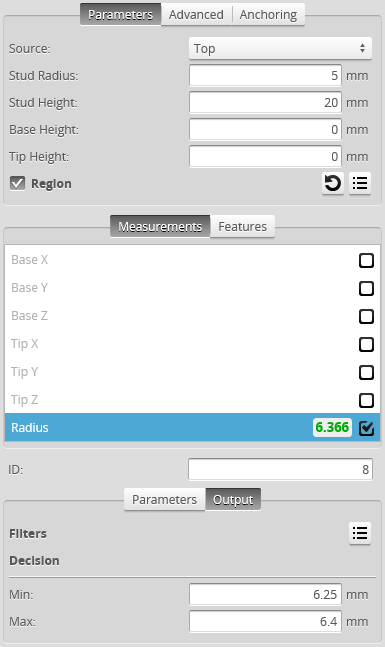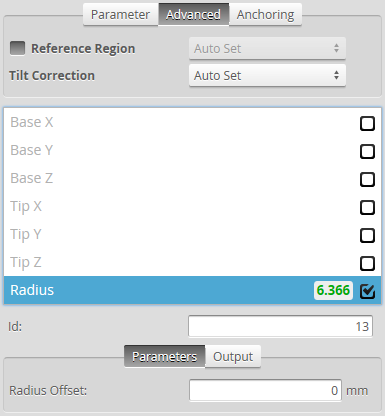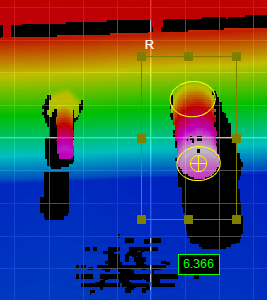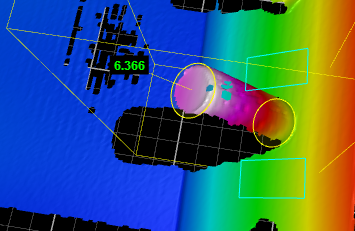Stud
|
The Stud tool measures the location and radius of a stud.
The tool uses a complex feature-locating algorithm to find a hold and then return measurements. See "Stud Algorithm" in the Gocator Measurement Tool Technical Manual for a detailed explanation of the algorithm. The behavior of the algorithm can be adjusted by changing the parameters in the measurement panel. The location of the stud is defined at either the stud tip or the stud base. The tip is the intersection of the stud axis and the top of the stud; the base is the intersection of the stud axis and the surrounding plane. |
|
||
|
The stud shape is defined by the tip height and base height. The base and tip heights specify where the shaft with the nominal radius begins and ends. |
|
|
2D View |
3D View |


Measurement Panel
For information on adding, managing, and removing tools and measurements, as well as detailed descriptions of settings common to most tools, see Tools Panel.
Measurements, Features, and Settings
| Measurement | Illustration |
|---|---|
|
Tip X Determines the X position of the stud tip. |
|
|
Tip Y Determines the Y position of the stud tip. |
|
|
Tip Z Determines the Z position of the stud tip. |
|
|
Base X Determines the X position of the stud base. |
|
|
Base Y Determines the Y position of the stud base. |
|
|
Base Z Determines the Z position of the stud base. |
|
|
Radius Determines the radius of the stud. |
|
| Type | Description |
|---|---|
| Tip Point |
The center point of the tip of the stud. |
| Base Point |
The center point of the base of the stud. |

|
For more information on geometric features, see Geometric Features. |
| Parameter | Description |
|---|---|
|
Source |
The sensor |
|
Stud Radius |
Expected radius of the stud. |
|
Stud Height |
Expected height/length of the stud. |
|
Base Height |
The height above the base surface that will be ignored when the (truncated) cone is fit to the stud data. |
|
Tip Height |
The height from the top of the surface that will be ignored when the (truncated) cone is fit to the stud data. |
|
Region |
The region to which the tool's measurements will apply. For more information, see Regions. |
|
Reference Regions |
The tool uses the reference regions to calculate the base plane of the stud. Reference regions are relative to the base of the stud. |
|
Tilt Correction |
Tilt of the target with respect to the alignment plane. Autoset: The tool automatically detects the tilt. The measurement region to cover more areas on the surface plane than other planes. Custom: You must enter the X and Y angles manually in the X Angle and Y Angle parameters (see below). |
|
X Angle Y Angle |
The X and Y angles you must specify when Tilt Correction is set to Custom. You can use the Surface Plane tool's X Angle and Y Angle measurements to get the angle of the surrounding surface, and then copy those measurement's values to the X Angle and Y Angle parameters of this tool. |
|
Radius Offset (Radius measurement only) |
The distance from the tip of the stud from which the radius is measured. |
|
Filters |
The filters that are applied to measurement values before they are output. For more information, see Filters. |
|
Decision |
The Max and Min settings define the range that determines whether the measurement tool sends a pass or fail decision to the output. For more information, see Decisions. |
| Anchor | Description |
|---|---|
|
X |
Lets you choose the X |

|
A measurement must be enabled in the other tool for it to be available as an anchor. The anchor measurement should also be properly configured before using it as an anchor. |

|
For more information on anchoring, see Measurement Anchoring. |
Measurement Region
The tip and the side of the stud must be within the measurement region.





